Is Shrimp Good in Ramen Noodles?
Lime chili shrimp ramen is my favorite during early spring when the nights are still cool.
Shrimp is an exceptional choice for the main protein in ramen noodle soup! Its delicate sweetness complements the savory broth, creating a satisfying, balanced flavor. Shrimp’s tender yet slightly firm texture provides a pleasant contrast to the soft, slurpy noodles. Moreover, shrimp cooks quickly, so adding it at the right time ensures it remains succulent and juicy without losing its natural flavors to the broth.
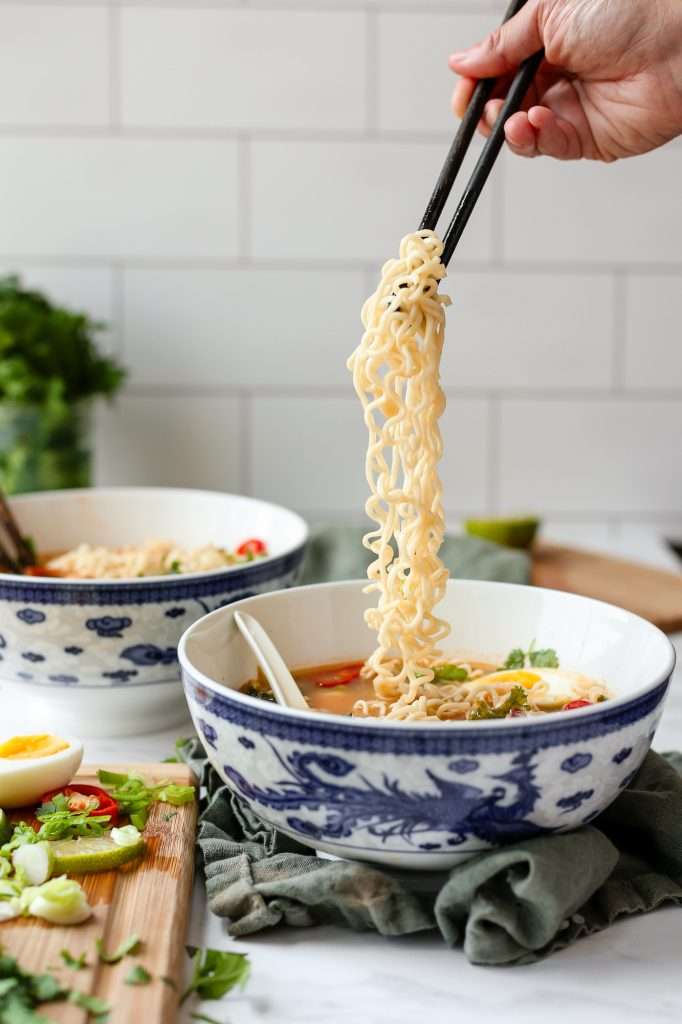
Shrimp is also a healthy option for ramen. It is rich in protein, low in calories, and packed with essential nutrients such as omega-3 fatty acids, vitamins B12 and D, and minerals like selenium and iodine. These nutrients contribute to various health benefits, including improved heart health, brain function, and immune support. Incorporating shrimp into ramen enriches the dish’s taste and boosts its nutritional profile, making it a wholesome and delectable meal.

Spicy Lime Chili Shrimp Ramen Ingredients
Here are all the ingredients you need to make this delicious lime chili shrimp ramen:
- 2-3 pounds shrimp
- 6 cups chicken or seafood broth
- 1-quart coconut water
- 1/3 cup tamari or soy sauce
- 1/4 cup fermented sriracha
- 1/4 cup tahini
- 2 yellow onions, minced
- 6 cloves garlic, minced
- 1 tablespoon fresh ginger, peeled and minced
- 1/4 cup lime juice
- 5 cups kale, chopped
- dry ramen noodles
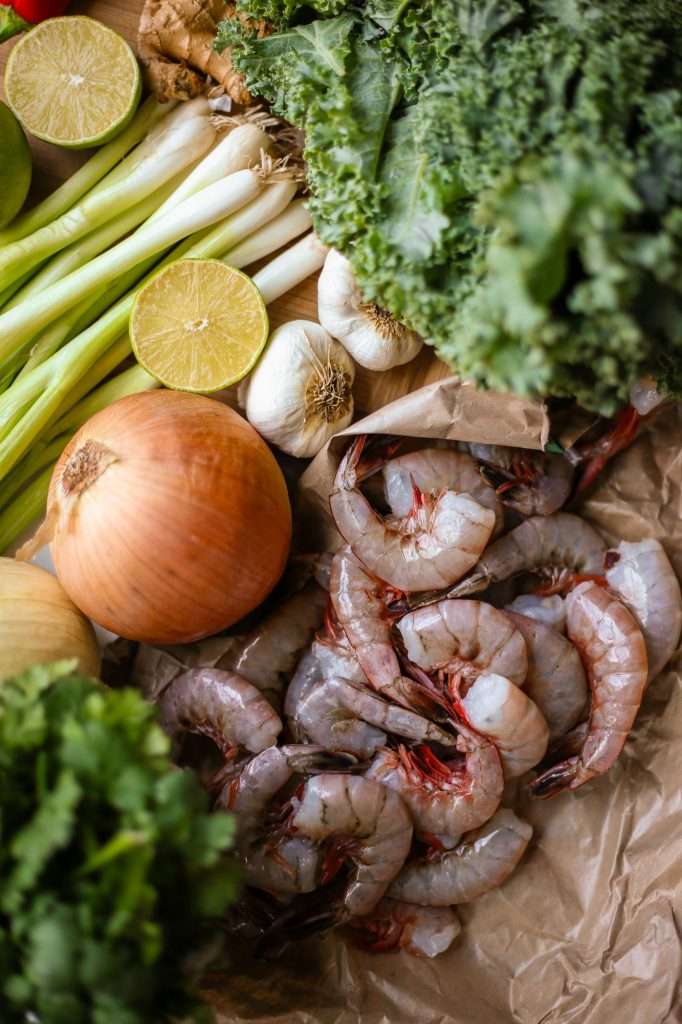
Equipment you need (one of the following):
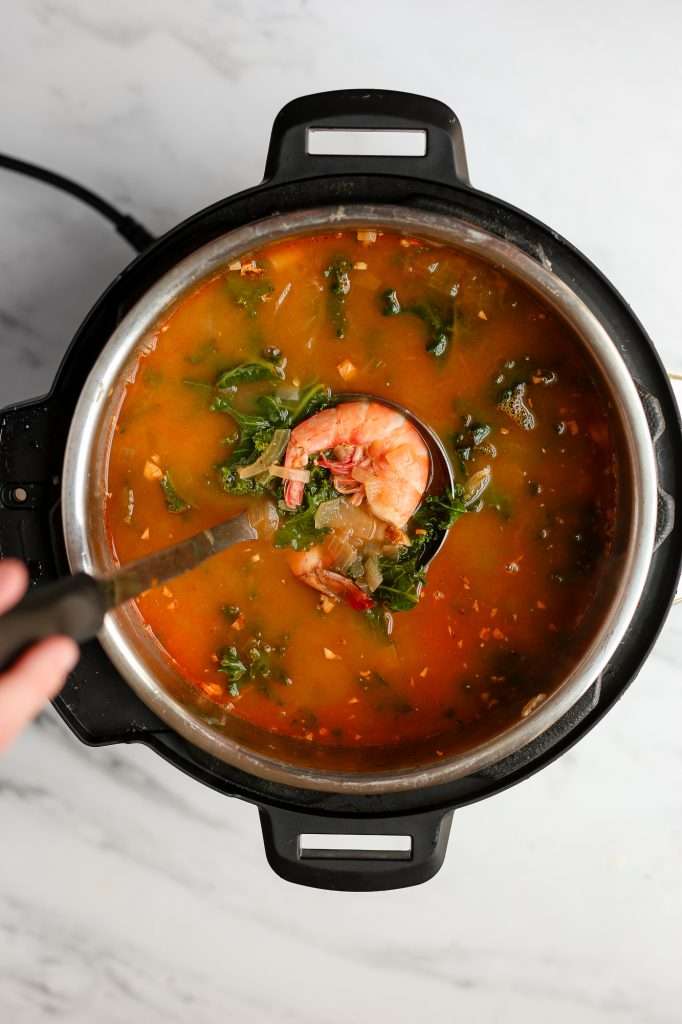
How to Jazz Up Shrimp Ramen: Shrimp Ramen Toppings
Jazzing up lime chili shrimp ramen is all about enhancing the rich, savory broth and getting creative with toppings.
We start with a robust broth infused with flavors from sriracha, lime juice, coconut, garlic, and ginger to lay a flavorful foundation. Then, you can get creative, elevating your shrimp ramen with various vibrant toppings.
I always love to include a soft-boiled egg, which adds creaminess, while fresh scallions and cilantro bring freshness. For a bit of crunch, you can include bean sprouts or toasted sesame seeds. Add some heat with sliced chili peppers or spicy chili oil.
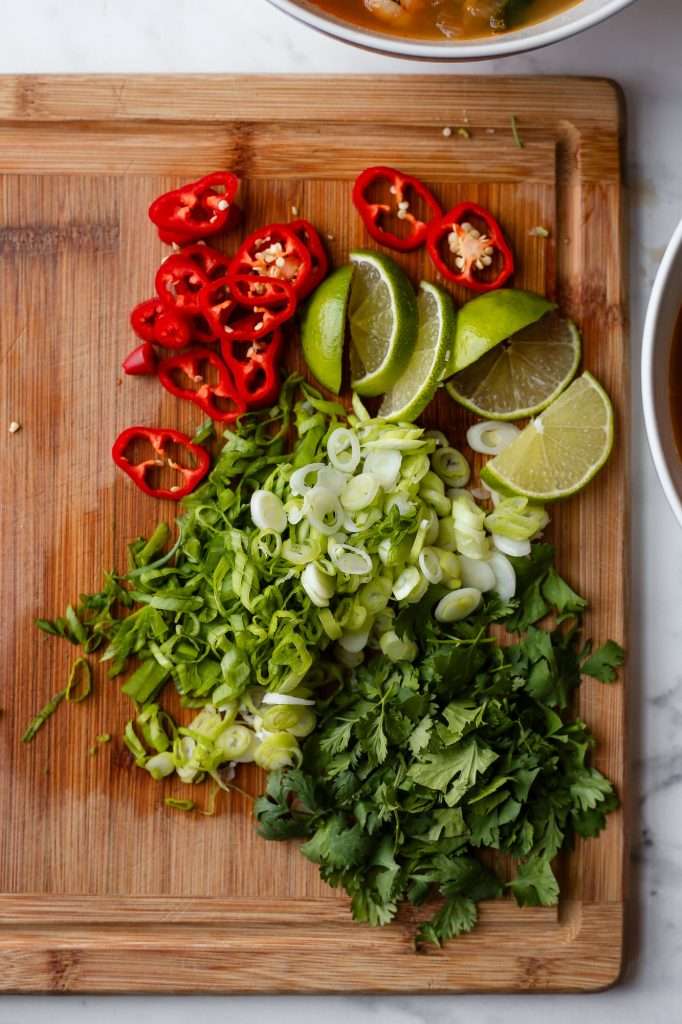
Here are the toppings I used:
- Fresh green onions, chopped
- Cilantro, chopped
- Lime wedges
- Chili slices
- Soft boiled eggs
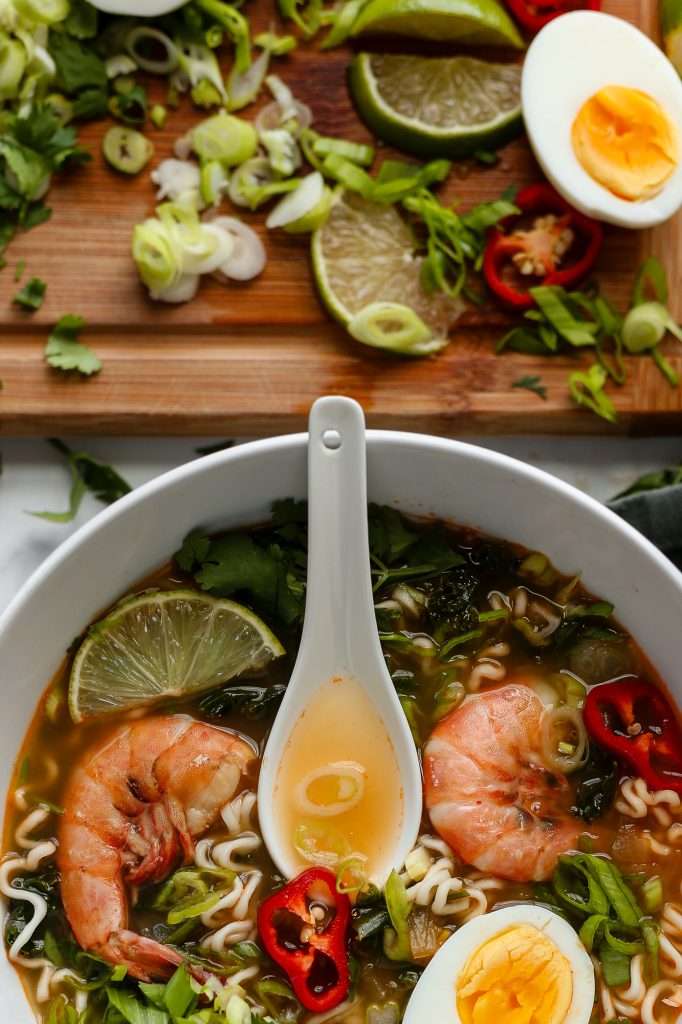
Fermented Sriracha in Lime Chili Shrimp Ramen
I love making my sriracha at home! It’s much better than store-bought, and fermentation brings the flavor to the next level.
CLICK HERE to learn how to make your own fermented garlic sriracha hot sauce at home. It’s easier (and cheaper) than you think! To make sriracha, you’ll need red jalapenos. However, this recipe can be adapted to make garlic hot sauce with many types of hot peppers.

The History of Ramen Noodle Soup
Ramen, the beloved Japanese noodle soup, boasts a storied history as diverse as its flavorful variations.
While its precise origin is somewhat debated, it’s widely believed that ramen’s roots lie in China. Chinese immigrants introduced wheat noodles to Japan in the late 19th century, influencing the development of what we now know as ramen.
The first documented appearance of ramen in Japan was at a Chinese restaurant in Yokohama in the early 20th century. Initially, it was a Chinese specialty, but it rapidly evolved into a Japanese culinary icon. The dish was trendy among students and workers for its affordability and hearty nature.
Throughout the 20th century, ramen experienced a culinary transformation, adapting to Japanese tastes and regional preferences. Various regions in Japan developed their distinctive styles of ramen, resulting in an exciting array of flavors and ingredients.
Some of the notable regional variations include:
- Shoyu Ramen: Originating in Tokyo, this ramen features a clear, soy sauce-based broth, often paired with thin, curly noodles and toppings like seaweed, green onions, and char siu (roasted pork).
- Miso Ramen: Hailing from Hokkaido, this ramen incorporates a rich and hearty miso (fermented soybean paste) broth, offering a unique umami flavor. People often serve this ramen with corn, butter, and bean sprouts.
- Tonkotsu Ramen: A specialty of Kyushu, this ramen features a creamy, pork bone-based broth that’s simmered for hours. It’s accompanied by thick, straight noodles garnished with pickled ginger and garlic.
- Shio Ramen: A lighter, salt-based ramen popular in various regions of Japan, known for its simple, delicate broth and a range of toppings, including seafood, vegetables, and more.
- Tsukemen: This style involves dipping cold noodles into a rich, concentrated broth, offering a unique and intense ramen experience.
In recent years, ramen has become a global sensation, with chefs and home cooks putting their unique twists on this iconic dish worldwide.
From the bustling streets of Tokyo to trendy ramen shops in New York City, ramen’s enduring appeal lies in its adaptability. It’s so adaptable that you can even make lime chili shrimp ramen.
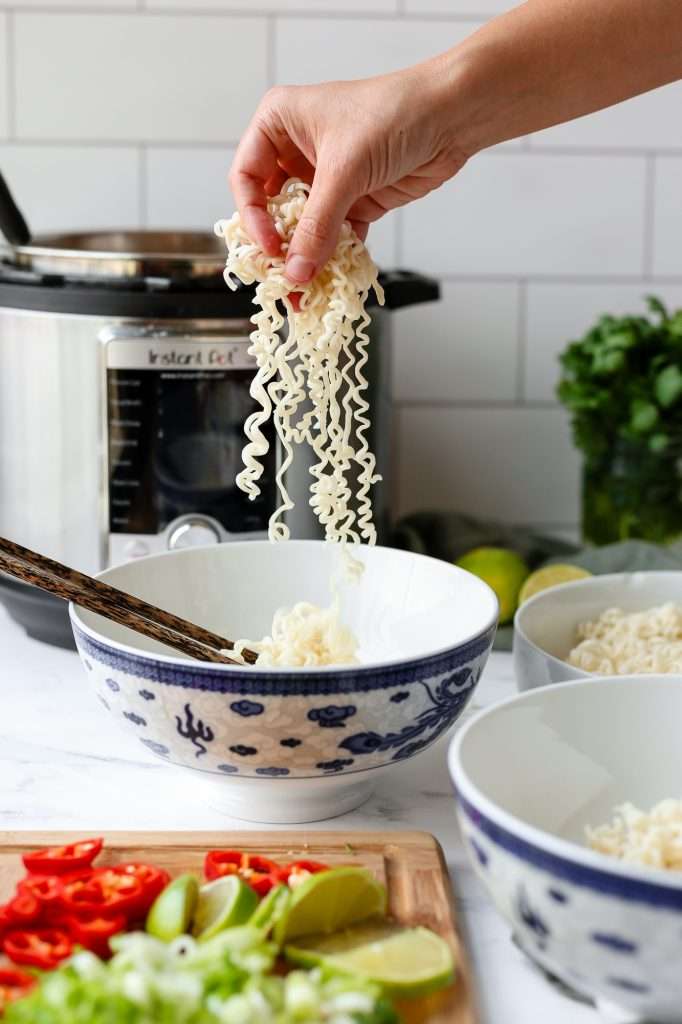
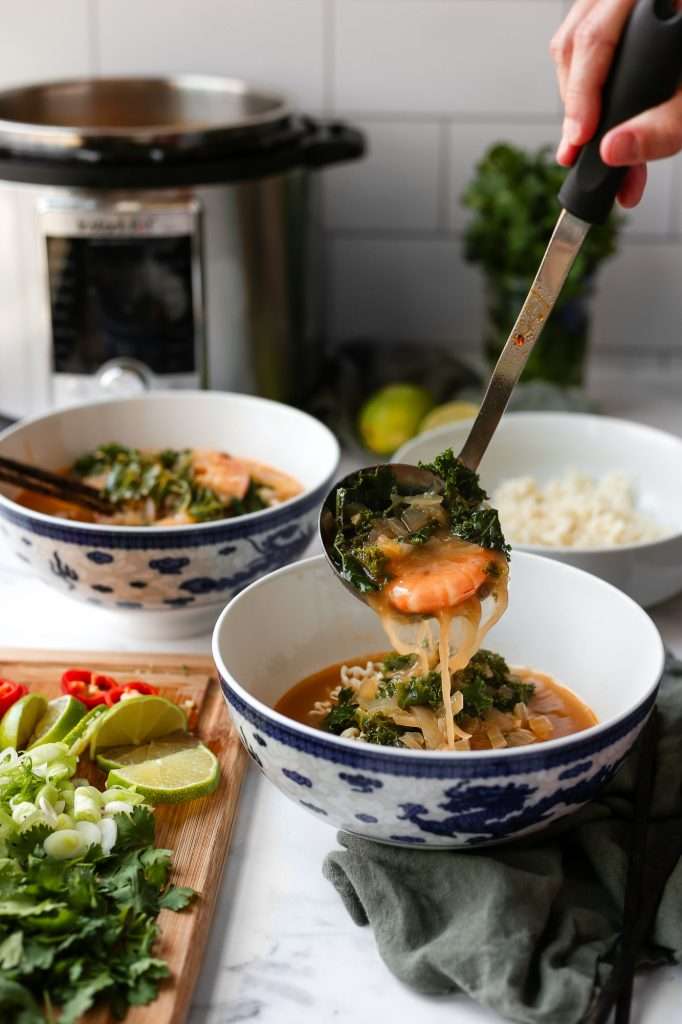
More Soup Recipes to Try
- Creamy Chicken Ramen Slow Cooker Recipe
- Authentic Cajun Seafood Gumbo with Crab, Shrimp and Mussels
- Creamy Roasted Carrot Soup with Ginger and Miso
- Thai Red Curry Ramen with Coconut Milk and Cilantro
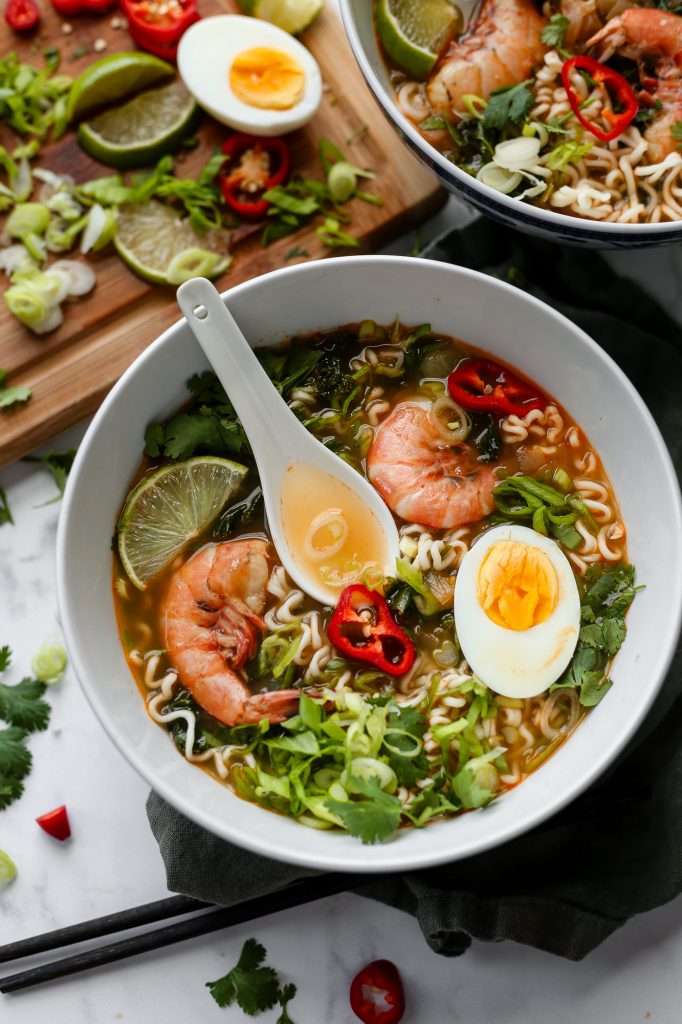

Lime Chili Shrimp Ramen with Nourishing Coconut Broth
An easy recipe for lime chili shrimp ramen made from scratch and slow-cooked to perfection. This is a slow cooker ramen made with freshly caught gulf shrimp, but you can also use other seafood in this recipe. You can also make this recipe with an instant pot or on the stovetop (directions for all methods are included).
- Prep: 45 minutes
- Cook: 3-6 hours
- Total Time: 0 hours
Ingredients
- 2–3 pounds shrimp*
- 6 cups chicken or seafood broth
- 1-quart coconut water
- 1/3 cup tamari or soy sauce
- 1/4 cup fermented sriracha*
- 1/4 cup tahini
- 2 yellow onions, minced
- 6 cloves garlic, minced
- 1 tablespoon fresh ginger, peeled and minced
- 1/3 cup lime juice
- 5 cups kale, chopped
- dry ramen noodles*
- fresh green onions, chopped
- cilantro, chopped
- lime wedges
- fermented pepper slices
- soft boiled eggs
Instructions
crockpot
- In the bowl of the crockpot, add the sriracha, tahini, onion, garlic, ginger, and lime juice. Pour over the broth, coconut water, and tamari. Cover and cook on low for 6 hours.
- Increase the heat on the slow cooker to high. Stir in the kale and shrimp, and cook uncovered for about 3 minutes.
- Taste the broth and add salt and more sriracha to taste if necessary.
- Add your noodles to a heat-safe bowl, and top with boiling water. Let the noodles soak until soft then drain.
- To make soft boiled eggs, bring water to a boil then boil eggs for 7-8 minutes. Immediately place the eggs in an ice water bath. Allow them to chill completely before peeling.
- Ladle the broth with shrimp and kale into bowls with the noodles.
- Top with cilantro, green onions, soft boiled eggs, pepper slices, and lime wedges. Serve immediately.
Stove
- To a large stock pot with a lid, add the sriracha, tahini, onion, garlic, ginger, and lime juice. Pour over the broth, coconut water, and tamari. Cover and cook on medium at a simmer for about 2 hours.
- Increase the heat to a simmer. Stir in the kale and shrimp, and cook uncovered for about 3 minutes.
- Taste the broth and add salt and more sriracha to taste if necessary.
- Add your noodles to a heat-safe bowl, and top with boiling water. Let the noodles soak until soft then drain.
- To make soft boiled eggs, bring water to a boil then boil eggs for 7-8 minutes. Immediately place the eggs in an ice water bath. Allow them to chill completely before peeling.
- Ladle the broth with kale and shrimp into bowls with the noodles.
- Top with cilantro, green onions, soft boiled eggs, pepper slices, and lime wedges. Serve immediately.
Instant Pot
- To the instant pot insert pot, add the sriracha, tahini, onion, garlic, ginger, and lime juice. Pour over the broth, coconut water, and tamari.
- Seal the lid and cook on high pressure for 15 minutes. Allow the pressure to release naturally (about 1 hour).
- Turn the heat to sauté. Stir in the kale and shrimp, and cook uncovered for about 3 minutes.
- Taste the broth and add salt and more sriracha to taste if necessary.
- Add your noodles to a heat-safe bowl, and top with boiling water. Let the noodles soak until soft then drain.
- To make soft boiled eggs, bring water to a boil then boil eggs for 7-8 minutes. Immediately place the eggs in an ice water bath. Allow them to chill completely before peeling.
- Ladle the broth with shrimp and kale into bowls with the noodles.
- Top with cilantro, green onions, soft boiled eggs, pepper slices, and lime wedges. Serve immediately.
Notes
- you can peel the shrimp before adding it to the broth, or add the shrimp in with the peel. I like to leave the peel on for flavor, then everyone can peel theirs once served.
- This ramen is moderately spicy. You can decrease the amount of sriracha if you don’t like spicy food.
- For the noodles, use one serving of noodles per person based on the serving size on the noodle packaging.


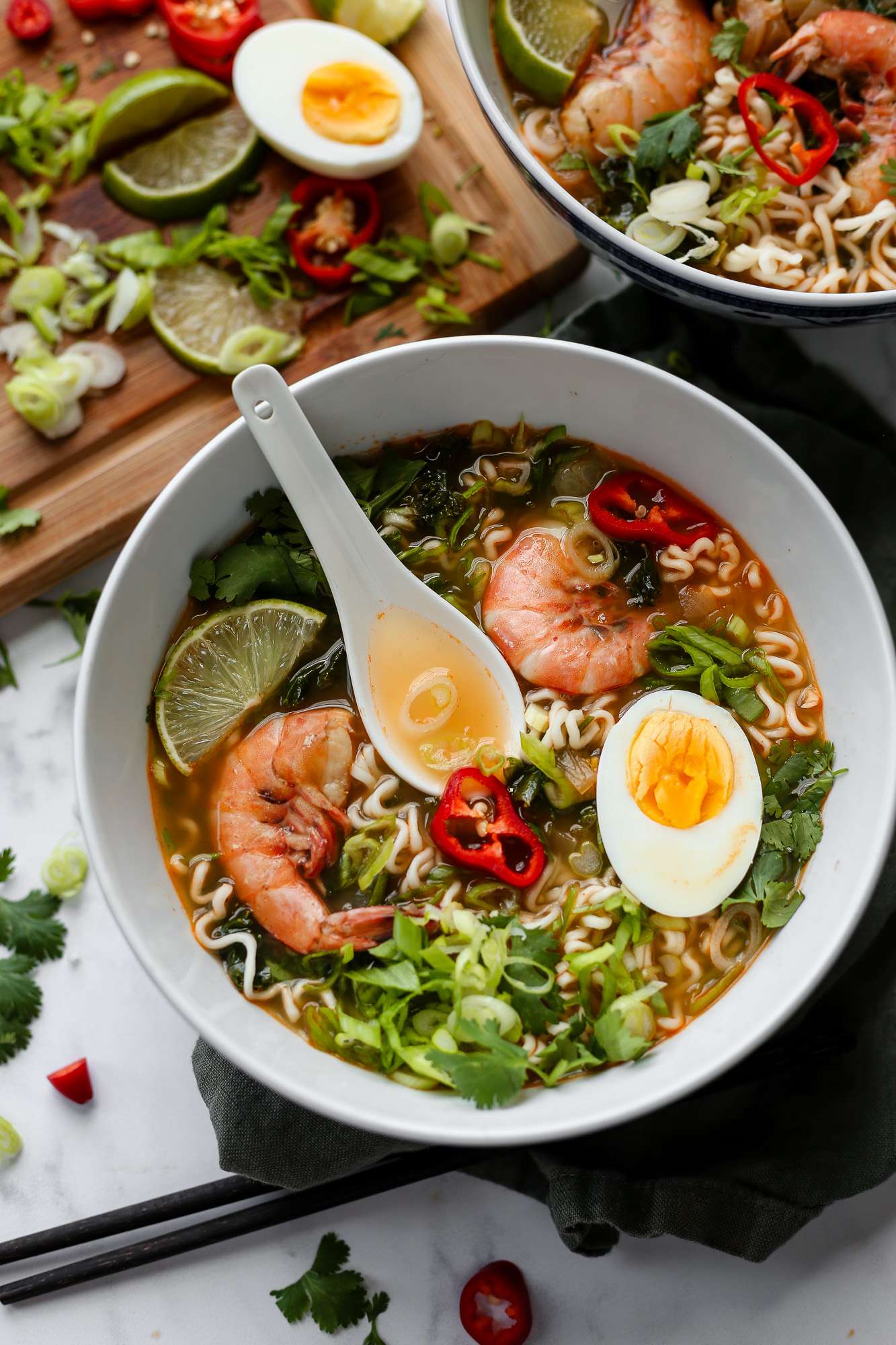












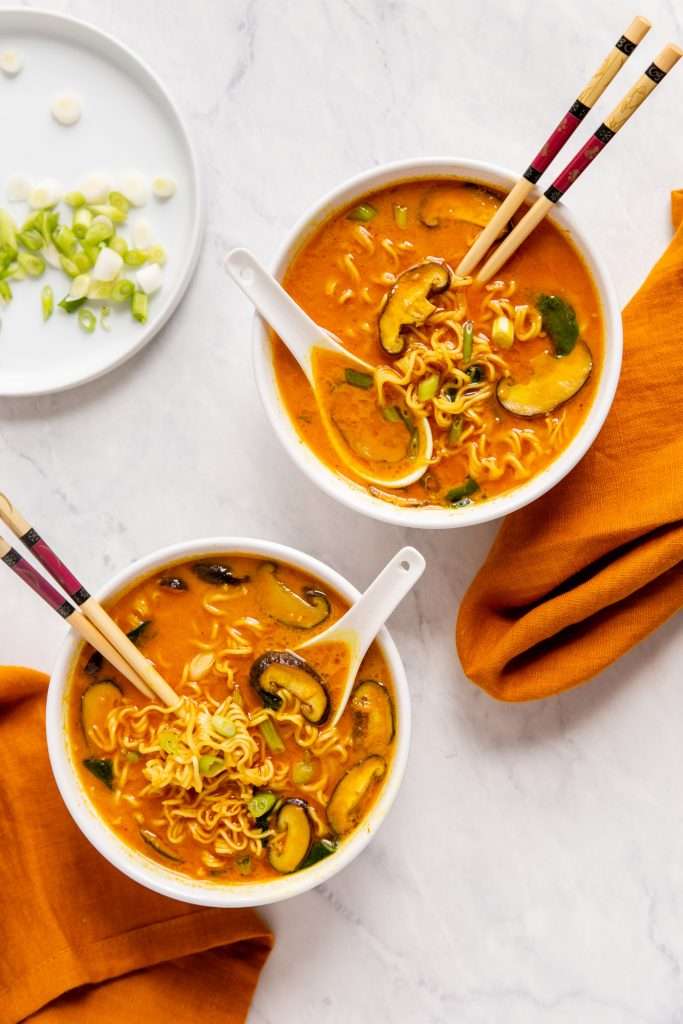

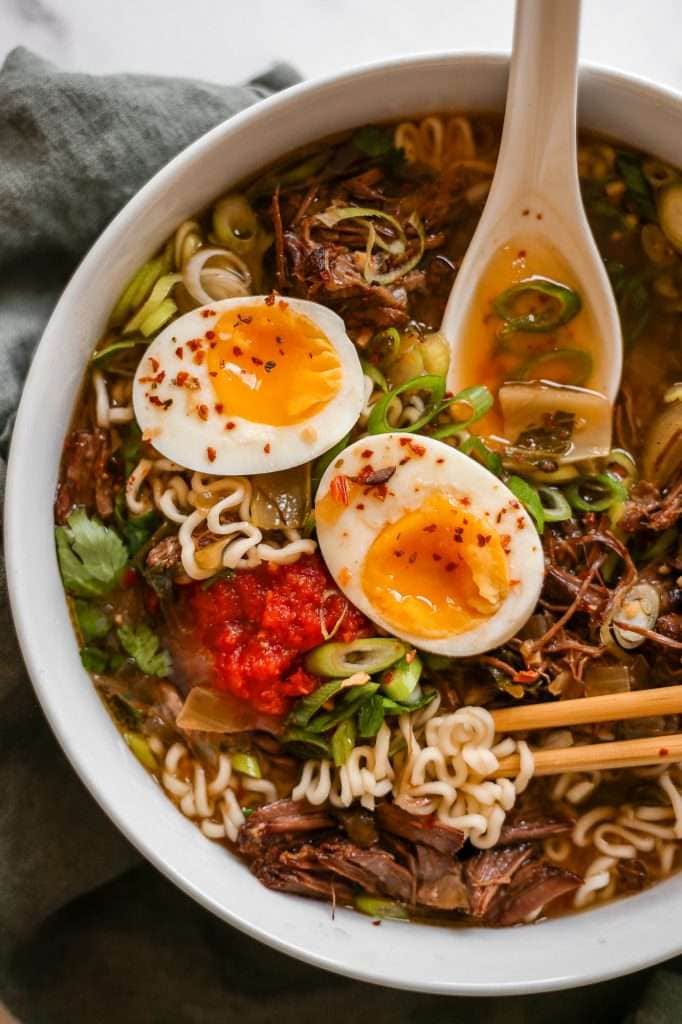



This recipe has my mouth watering and I can’t wait to try it! Unfortunately I don’t have access to quality fresh shrimp in my area. Would this work okay if I used thawed raw shrimp from frozen instead or would I need to change any of the cooking times or temps? Thanks!!
Yes thawed raw shrimp will work great! As long as they’re fully thawed, all the directions will remain the same.
Thank you so much! Can’t wait to try it out!
Years ago, I went to an Asian restaurant. It was a small tiny little place in Cerritos California. I’m not sure if it was Vietnamese or Thai food. All I know is that this is similar to yours, except the noodles were flat and there was a lot of Kiefer leaves which turned this Ball of deliciousness into something fabulous I wish I knew that recipe as I would make it all the time it had coconut milk in it that is for sure along with the Kiefer leaves and shrimp recipe is the closest I have come, which was yummy also, I wish I could find And the recipe.